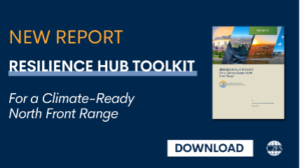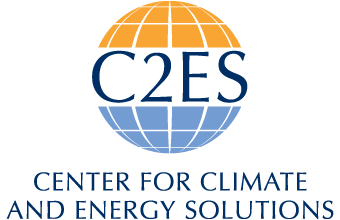Many organizations and local governments operate community centers and spaces that provide daily benefits to residents. As disasters like the 2021 Marshall Fire and 2025 LA fires become more common, community leaders have an opportunity to develop “resiliency hubs” to serve vulnerable communities in extreme weather.
As part of C2ES’s Climate Resilient Communities Accelerator pilot in the North Front Range of Colorado, we created the Resilience Hub Toolkit. Stakeholders from public and private sectors were interested in learning how community spaces could be enhanced to help residents prepare, withstand, and recover from regional hazards like wildfire and extreme heat.
This publication draws on existing resources, including leading edge work from the Urban Sustainability Directors Network, and is tailored to the region with input from over 65 key stakeholders, including around a dozen local governments, a range of community-based organizations and NGOs, state and federal agencies, and private sector companies from the consulting, energy, finance, healthcare, and technology worlds.
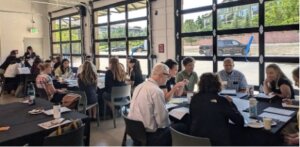
What is a Resilience Hub?
One of the first questions we asked was: what exactly is a resilience hub? At its core, a resilience hub is a community-serving facility enhanced to provide critical resources to residents not only during disasters but also on a day-to-day basis.
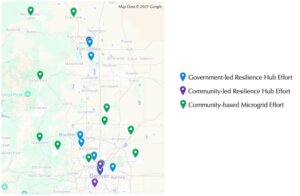 Each hub is unique, designed to meet the specific needs of the local community it serves.
Each hub is unique, designed to meet the specific needs of the local community it serves.
The Alliance for a Sustainable Future–a joint effort of C2ES and The U.S. Conference of Mayors– recently released a new report with case studies from across the country to share valuable insights into how different communities are developing and implementing resilience hubs.
One key strategy is building capacity during “blue sky” days to ensure the community is prepared for “gray sky” events like power outages, heat waves, or wildfires. A hub can become more resilient and energy secure by incorporating a microgrid, which is a small-scale power system that provides electricity during grid disruptions.
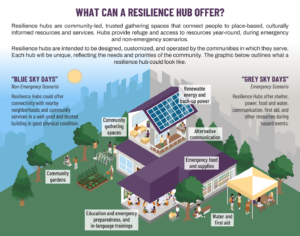
For example, the Boyle Heights Arts Conservancy in Los Angeles provides daily support to residents in the creative arts, media, and technology industries through job training, bilingual radio, youth arts, and senior services. During the 2025 LA fires, the Conservancy quickly mobilized to provide Wi-Fi, power, air conditioning, refreshments, and KN95 masks to affected students and artists, and partnered with the Red Cross to distribute self-care kits.
Mapping the State of Play: Resilience Hubs in Colorado’s North Front Range
While developing this toolkit, we discovered a collection of local hub efforts, both established and in development, that are spearheaded by community-based organizations and local governments. Additionally, electric utilities are integrating microgrids with critical community assets and emergency services.
A resilience hub network is a coordinated system of interconnected hubs that collaboratively enhance community preparedness, response, and recovery by sharing resources, expertise, and support across multiple locations. With more hubs emerging in the North Front Range region, there is an opportunity to take a network approach, enabling more efficient disaster response and stronger community resilience at scale.
Today, resilience hub networks are being developed in several major cities across the United States, including in Baltimore, Maryland, East Bay, California, Miami-Dade County, Florida, and Seattle-Tacoma, Washington. Houston, Texas, developed a robust Resilience Hub Network Strategy in response to the devastating Hurricane Harvey in 2017. It envisions a coordinated network of resilience “hubs” (city-owned centers), “super spots” (major community-owned centers), “spots” (faith-based and other nonprofit facilities that compliment hubs), and “spokes” (public transit, sidewalks, bike lanes, and other infrastructure that connect hubs, super spots, and spots).
Lessons Learned
Through our collaborative process, we explored the key factors necessary to develop a successful resilience hub. These can include forming supportive partnerships and securing diverse financial resources; there are many opportunities available to communities in Colorado and beyond. We also examined how a hub’s location, components, and programming can best serve vulnerable communities facing regional climate hazards, like wildfire and extreme heat. For example, a wildfire-ready resilience hub would be located outside of fire risk zones yet accessible by residents in risk zones, feature non-combustible materials, air filtration, emergency supplies, water storage, and backup power, and be surrounded by defensible space.
A key lesson learned is the value of having an established resilience hub in place before a disaster strikes. The Superior Community Center, which opened just six months before the Marshall Fire, quickly became a vital gathering place for the community, providing immediate access to resources and support. Today, it continues to serve residents and businesses as they navigate long-term rebuilding and recovery. This example, along with other innovative efforts, is highlighted in the toolkit’s case studies to showcase real-world applications and best practices.
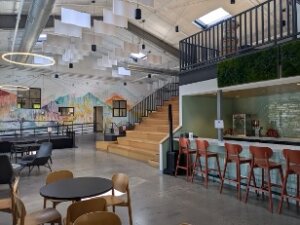
Call to Action: Explore the Toolkit and Start the Conversation
The newly launched toolkit provides a roadmap for Colorado communities interested in developing resilience hubs. We invite you to explore and share the toolkit to start a conversation on resilience hubs with your colleagues, neighbors, and other potential partners.
C2ES launched this new toolkit during a virtual event featuring keynote remarks from Colorado Governor Jared Polis and presentations from community and state leaders sharing a range of approaches to advance resilience hubs in the Front Range. 